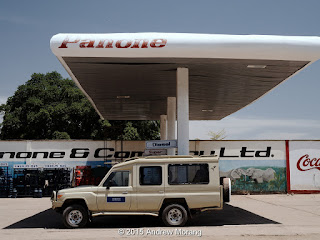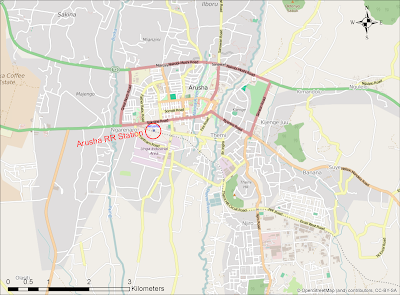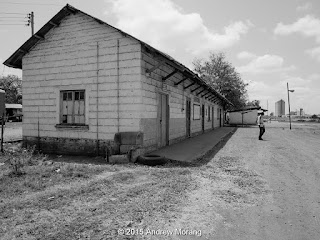This is the view west along West Porter at sunset in November.
This blog documents what remains when we abandon our buildings, homes, schools, and factories. These decaying structures represent our impact on the world: where we lived, worked, and built. The blog also shows examples of where decay was averted or reversed with hard work and imagination.
Thursday, December 17, 2015
More Urban Decay: West Porter Street, Jackson, Mississippi
This is the view west along West Porter at sunset in November.
Sunday, December 13, 2015
Arusha with Film Emulations
This is the simulation of Kodak Ektar 100 film. It was an excellent emulsion and looked a lot like the pure digital capture. Note that this was a negative film, meaning it was intended for printing on color print paper. Depending on the type of paper used and the filtration during printing, the final print might look quite different.
Here is my favorite slide film from the past, Kodachrome 25. Note the "clean" high contrast appearance.
Here is my favorite black and white film, Kodak Tri-X, with yellow filter added to enhance contrast a little. You can still buy Tri-X in various sizes.
Finally, here is the Kodak BW400CN black and white film with red filter. The BW400CN was discontinued in 2014 but can still be found in bulk on ePrey. This was a convenient film because it was developed in C-41 chemicals at any color print lab (in other words, color print film but with monochrome dyes only). It scanned well - buy some while you can.
This is the abandoned railroad station. This is the standard digital output with good exposure range and reasonably realistic colors.
Here is the same scene but processed with DxO FilmPack 5 with the Kodak Tri-X film emulation. I added the yellow filter, which darkened the sky when using real Ti-X. Depending on filtration (green, yellow, orange, red, etc.) there are almost endless ways you can modify the tonality.
Her is another scene from the rail yard, the standard digital RAW file opened in Adobe camera Raw 7.4.
Here is a film that DxO labeled as Generic Kodachrome. Note the bright blue of the warehouse in the distance. The Kodachrome of the 1950s and 1960s was highly saturated, resulting in the "Kodachrome look." Kodachrome is gone forever, but many other films are still available. Borrow a film camera and try some traditional (real) photography as an aesthetic challenge.
Friday, December 11, 2015
Hanging Around in Mto Wa Mbu, Tanzania
Mto Wa Mbu is on Route B144 just north of Manyara National Park and a few kilometers north of Tarangire National Park, Tanzania. It is about 3 hours drive west of Arusha, and most tourists probably rush on through unless they need some diesel.
This is a cheerful town. There were people fixing things, carrying bags of grain or rice, working on motor scooters, and selling souvenirs. I do not understand: Tanzania is a poor country, but it looks like it is on the way up. Streets are being paved, people are working, internet is spreading, shops sell goods, traffic is heavy, farmers are busy, small schools and training academies thrive, and the people are proud, cheerful, and polite. But when I drive through the Mississippi Delta, Greenville, Rolling Fork, or even Jackson, the towns are crumbling and dirty, demonstrating our race to the bottom. Enough said.
As I wrote above, Mto Wa Mbu is a transit point en route to the national parks. Tarangire National Park, a few km south, is a place of profound beauty and peacefulness. We had wonderful birding and saw the usual cast of larger residents, such as elephants, gazelle, and baboons.
I took these photographs with a Panasonic Lumix G3 digital camera and the Panasonic 12-32mm lens. I opened the raw files with Adobe Photoshop Elements 11 (with Adobe Camera Raw 7.4) and then used the Kodachrome 25 film emulation in DxO FilmPack 5. The K25 increased contrast (as per the original film), so I had to reduce contrast when initially opening the RAW file. Also, on most, I increased exposure in the shadows to prevent their becoming completely featureless, so possibly I am not really replicating K25. But all in all, I like the K25 look; it reminds me of my film days.
Sunday, December 6, 2015
Last train to Arusha
The railroad was built in the early 20th century, during the great era of railroad-building around the world. The official Tanzanian railroad web page states,
"Construction of the 86.08 km Moshi-Arusha railway extension of the Tanga Line starting at Moshi in 1911 and reaching Arusha in 1929. The railway distance from Arusha to Tanga and Dar es Salaam is 437km and 644km respectively."
My guide, Morris, said the railroad was built by the Germans. He was partly correct because while the Germans were forced out of their African colonies in World War I, they certainly began the construction project when Tanzania was part of German East Africa. According to Wikipedia, Germany controlled this part of east Africa from the 1880s to 1919, when, under the League of Nations, it became a British mandate.
The buildings were intact and secure, so someone still takes responsibility.
The electric supply from the mains is a bit erratic in Arusha, meaning often there is no electricity.
Were there once 1st and 2nd class outhouse stalls? Odd.
Some gents were sitting at once of the platforms. Morris asked them if I could take their portrait. They said they did not see many white people (Westerners?) around there.
It was pretty sleepy on the track side of the depot. The bugs were buzzing, the sun blazing - time for a nap.
There was not much happening inside, either. The buildings are locked, so someone has possession. I hope they can one day restore train service.
I took these photographs with a Panasonic G3 digital camera with the Panasonic Lumix 12-32mm lens, and added a polarizing filter for scenes with sky. To convert to black and white, I opened the RAW files in Adobe Photoshop Elements (using ACR 7.3), then opened DxO FilmPack 5 to use one of the black and white emulations. Most of the time, the Kodak Tri-X was best, but on some very contrasty scenes, Kodak BW400CN retained detail in the shadows. I usually added the yellow filter to darken the sky a bit.
Tuesday, December 1, 2015
The Trees of Kilimanjaro
The map shows our route based on waypoints measured by my friend's Garmin GPS unit. On the way down via the southern route, you descend on the Mweka Trail to the Mweka Gate. Because the elevation changes so greatly, a trekker passes through distinct botanical/biological zones, ranging from alpine desert to jungle. This article is about the Trees of Kilimanjaro*.
* Sorry, I could not resist paraphrasing the title of Ernest Hemingway's 1936 short story, "The Snows of Kilimanjaro". It is about a hunter who is dying of gangrene. The 1952 film stars Gregory Peck, Ava Gardner, and Susan Hayward, with music by Bernard Herrmann. Quite a star-filled production.
Above Millenium camp, the terrain is a bare, dusty, terrain of rock and ground-up rock powder (see photograph no. 1). But at Millenium, you begin to see stunted trees and brush. And at 12,000 ft altitude, the air feels so thick after sleeping above 15,000 ft for three nights. I guess everything is relative.
Below the Millennium Camp, the trail passes into a spectacular forest of monstrous trees and ferns. It is so Jurassic Park, you wonder when a dinosaur will pop up from a valley. According to Wikipedia, the montane forests on the southern slopes contain Ocotea usambarensis as well as ferns and epipythes, while farther up in cloud forests, Podocarpus latifolius, Hagenia abyssinica and Erica excelsa thrive as well as fog-dependent mosses.
The trail is nicely-graded here and takes you relentlessly down. One thing we noticed is that the trail within the forest was no longer dusty but was hard-packed dirt. The trail crews had dug gutters and water troughs to control runoff in the wet season.
The tree ferns are gorgeous with backlighting.
And then there are the trees. Nothing subtle about this timber.
The trail reaches a jeep track with a resting tree for the porters. These guys are amazing considering the heavy packs, tents, and supplies they carry at over 15,000 ft to support trekking groups.
You continue to pass through a spectacular forest as long as you are in the Kilimanjaro National Park. In the lower areas, local villagers are allowed to harvest something (not sure what) from the forest floor. But they cannot cut timber.
Finally you reach the Mweka Gate at 1640 m elevation. You receive your official certificate (if you summited), as well as lunch and a beer. And if you are really lucky, an air-conditioned van is waiting to take you back to your hotel and a shower. We had a fabulous trip, and I thank Ed, Fred, and Zak for being such cheerful and great companions.
If you want to take your own trip to Kilimanjaro, I strongly recommend Embark Adventures of Portland, Oregon.
Photographs taken with a Panasonic G3 camera with Lumix 12-32mm lens. RAW files opened with Photoshop Elements and processed with DxO Filmpack 5, mostly with the Tri-X film emulation and yellow filter.






















































